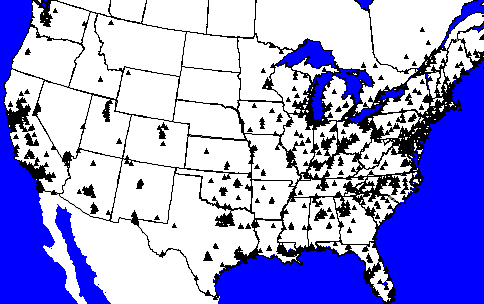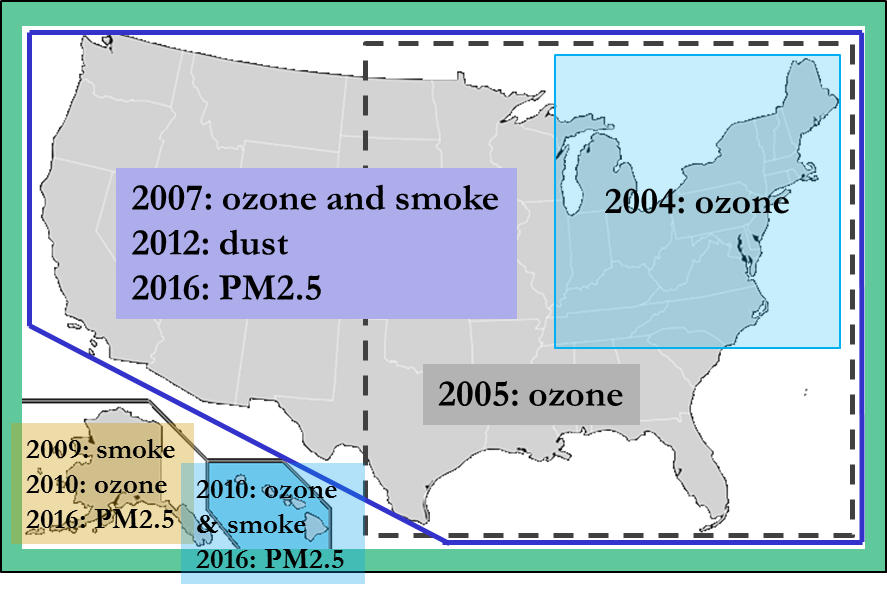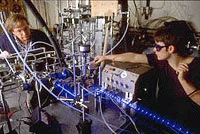About Air Quality Forecast Capability
The United States needs a national air quality forecasting (AQF) capability
Air quality has improved significantly in recent decades following passage of the Clean Air Act in 1970. However, there are still many areas of the country where the public is exposed to unhealthy levels of air pollutants and sensitive ecosystems are damaged by air pollution. The cost of poor air quality to the U.S. from air pollutionrelated illness alone has been estimated at $150 billion per year. Forecasting impending poor air quality can provide early notice and warning to individuals and communities to help them limit exposure and reduce asthma attacks, eye, nose, and throat irritation, other respiratory and cardiovascular problems, and even save lives. And for each 1 percent reduction in adverse health impacts that AQF could provide, over $1 billion would be saved every year. To help the nation realize these benefits, Congress has directed NOAA to provide national AQF guidance.

View of National Monument on clear and polluted air days.
NOAA and EPA have established a national AQF partnership
NOAA and EPA have entered into a partnership to make full use of their respective capabilities and authorities in developing a national AQF system. The goal of this partnership is to provide ozone, particulate matter, and other pollutant forecasts with enough accuracy and advance notice for people to take action to prevent or limit harmful effects from poor air quality.
State and local air quality agencies, as well as the private sector, are also essential partners in the national AQF Air quality monitoring network: EPA's national inventory of emissions data. EPA, through its relationships with state and local air quality agencies, collects air quality monitoring data and provides it to NOAA. NOAA incorporates these data and NOAA weather observations into operational AQF models developed concentration fields. State and local agencies use this guidance to issue air quality forecasts and Air Quality Index predictions in their jurisdictions. EPA nationally distributes this information from state and local air quality forecast agencies. The private sector uses and disseminates this information to the public as well.

https://airquality.weather.gov/
The NOAA/EPA partnership will provide more sophisticated tools and advance the power of air quality forecasting
Over the past decade, more state and local agencies have begun to make air quality forecasts for their communities. Today, about 400 cities nationwide are issuing air quality alerts, with the benefit of the kind of high-powered national forecasting technology and guidance that supports local weather forecasts. For localities that have been forecasting air quality, NOAA forecasting guidance improves forecasters' ability to predict the onset, severity, and duration of poor air quality. NOAA forecasting guidance is available nationwide even for communities without monitors or an official forecast.

Monitoring Stations
The national AQF capability will expand over the next decade
The initial deployment of NOAA's operational AQF guidance, which occurred in September 2004, provided one-day predictions of 1-hour and 8-hour average concentrations of ground-level ozone in the Northeastern United States (US). Subsequent deployments expanded the domain westward; nationwide ozone predictions have been provided twice per day since 2010. Smoke predictions are provided once per day for the 48 contiguous states (CONUS) since 2007 and nationwide since 2010. Dust predictions are provides twice daily for CONUS since 2012. Predictions of fine particulate matter (PM2.5) are provided publicly since February 2016. In a decade, predictions will be extended to two days or beyond.

Model Grid Expansions
NOAA atmospheric research supports advances in AQF
NOAA scientists are conducting research crucial for improving our ability to predict and monitor changes in air quality, including air pollutant transport, air pollutant transformation processes, atmospheric deposition, particulate matter characterization, and tropospheric ozone reaction and transport processes. The data and analyses provided will help establish the basis for building next generation air quality forecasts even as the initial National Air Quality Forecasting capability is made available.

NOAA scientists conduct experiments to study the reactions and properties of atmospheric gases/particles that are important in air quality.
Ozone and particulate matter cause a range of adverse health effects
Ozone
Ground-level ozone (O3) is a product of nitrogen oxides (NOx) and volatile organic compounds (VOCs) in the presence of heat and sunlight. Motor vehicle exhaust, industrial emissions, gasoline vapors, and chemical solvents are among the major sources of NOx and VOCs responsible for harmful buildup of ground-level ozone. Even at low concentrations, ozone can trigger a variety of health problems such as lung irritation and inflammation, asthma attacks, wheezing, coughing, and increased susceptibility to respiratory illnesses.
Particulate matter (PM)
Particulate matter (PM), or airborne particles, include dust, dirt, soot, and smoke. Some particles are directly emitted into the air by, for example, cars, trucks, buses factories, construction sites, and wood burning. Other particles are formed in the air when gases from burning fuels react with sunlight and water vapor. Such gases, from incomplete combustion in motor vehicles, at power plants and in other industrial processes, contribute indirectly to particulate pollution. PM can cause chronic bronchitis, asthma attacks, decreased lung function, coughing, painful breathing, as well as a variety of serious environmental impacts such as acidification of lakes and streams and nutrient depletion in soils and water bodies.
About the Agency Missions
NOAA Mission
The Commerce Department's National Oceanic and Atmospheric Administration (NOAA) is dedicated to enhancing national safety, economic security, and environmental stewardship through analysis, prediction and research of weather, water and climate-related events.
Visit NOAA on the web at:https://www.noaa.gov/
EPA Mission
The Environmental Protection Agency's (EPA's) mission is to protect human health and to safeguard the natural environment -- air, water, and land -- upon which life depends. For 30 years, EPA has been working for a cleaner, healthier environment for the American people.
Visit EPA on the web at:https://www.epa.gov/

